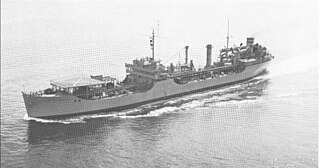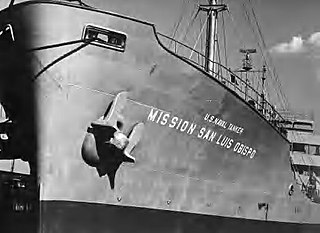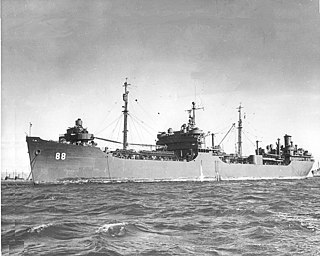
SS Mission San Juan was a Type T2-SE-A2 tanker built for the United States Maritime Commission during World War II. After the war she was acquired by the United States Navy as USS Mission San Juan. Later the tanker transferred to the Military Sea Transportation Service as USNS Mission San Juan. She was a member of the Mission Buenaventura-class oiler and was named for Mission San Juan Bautista in San Juan Bautista, California.

SS Mission Capistrano was a Type T2-SE-A2 tanker built for the United States Maritime Commission during World War II. After the war she was acquired by the United States Navy as USS Mission Capistrano (AO-112). Later the tanker transferred to the Military Sea Transportation Service as USNS Mission Capistrano (T-AO-112). She was a Mission Buenaventura-class oiler and was named for San Juan Capistrano in San Juan Capistrano, California.

SS Mission Buenaventura was a Type T2-SE-A2 tanker built for the United States Maritime Commission during World War II. After the war she was acquired by the United States Navy as USS Mission Buenaventura (AO-111). Later the tanker transferred to the Military Sea Transportation Service as USNS Mission Buenaventura (T-AO-111). The lead ship in her class of fleet oilers, she was named for Mission San Buenaventura located in Ventura, California.

SS Mission San Gabriel was a Type T2-SE-A2 tanker built for the United States Maritime Commission during World War II. After the war she was acquired by the United States Navy as USS Mission San Gabriel (AO-124). Later the tanker transferred to the Military Sea Transportation Service as USNS Mission San Gabriel (T-AO-124). She was a member of the Mission Buenaventura-class oiler and was named for the Mission San Gabriel Arcángel, she was the only U.S. Naval vessel to bear the name.

SS Mission Dolores was a Mission Buenaventura-class oiler built for the United States Maritime Commission during World War II, named for Mission San Francisco de Asís in San Juan Capistrano, California, one of two named for the Franciscan mission located in San Francisco, California.

USNS Redstone, designated T‑AGM‑20, was a tracking ship assigned to Apollo space mission support under the control of the Eastern Range. For a brief time during conversion the ship was named Johnstown with the designation AGM‑20.
SS Mission San Antonio was a Type T2-SE-A2 tanker built for the United States Maritime Commission during World War II. After the war she was acquired by the United States Navy as USS Mission San Antonio (AO-119). Later the tanker transferred to the Military Sea Transportation Service as USNS Mission San Antonio (T-AO-119). She was a Mission Buenaventura-class oiler and was named for Mission San Antonio de Padua located near Jolon, California.

SS Mission San Diego was a Type T2-SE-A2 tanker built for the United States Maritime Commission during World War II. After the war she was acquired by the United States Navy as USS Mission San Diego (AO-121). Later the tanker transferred to the Military Sea Transportation Service as USNS Mission San Diego (T-AO-121). She was a member of the Mission Buenaventura-class oiler and was named for the Mission San Diego de Alcalá.

SS Mission San Fernando was a Type T2-SE-A2 tanker built for the United States Maritime Commission during World War II. After the war she was acquired by the United States Navy as USS Mission San Fernando (AO-122). Later the tanker transferred to the Military Sea Transportation Service as USNS Mission San Fernando (T-AO-122). She was a member of the Mission Buenaventura-class oiler and was named for Mission San Fernando Rey de España in Los Angeles. She was later renamed USNS Muscle Shoals (T-AGM-19), and, later, USNS Vanguard (T-AG-194).
SS Mission San Jose was a Type T2-SE-A2 tanker built for the United States Maritime Commission during World War II. After the war she was acquired by the United States Navy as USS Mission San Jose. Later the tanker transferred to the Military Sea Transportation Service as USNS Mission San Jose. She was a Mission Buenaventura-class oiler and was named for Mission San José, located in Fremont, California.

USNS Mission Santa Ana (T-AO-137) was a Mission Buenaventura-class oiler that served in the United States Navy. The ship was originally intended as USS Concho (AO-102) for the U.S. Navy but her acquisition was canceled. The ship, a Type T2-SE-A3 tanker, was completed as SS Mission Santa Ana and delivered after the end of World War II. The tanker was acquired by the U.S. Navy in 1948 as USS Mission Santa Ana (AO-137), but was transferred to the Military Sea Transport Service upon its creation in 1949. The ship was named for the Santa Ana Estancia, she was the only U.S. Naval Vessel to bear the name.

SS Mission San Luis Obispo was a Type T2-SE-A2 tanker built for the United States Maritime Commission during World War II. After the war she was acquired by the United States Navy as USS Mission San Luis Obispo (AO-127). Later the tanker transferred to the Military Sea Transportation Service as USNS Mission San Luis Obispo (T-AO-127). A Mission Buenaventura-class oiler, she was named for Mission San Luís Obispo de Tolosa in San Luis Obispo, California.
SS Mission San Luis Rey was a Type T2-SE-A2 tanker built for the United States Maritime Commission during World War II. After the war she was acquired by the United States Navy as USS Mission San Luis Rey (AO-128). Later the tanker transferred to the Military Sea Transportation Service as USNS Mission San Luis Rey (T-AO-128). She was a Mission Buenaventura-class oiler and was named for Mission San Luis Rey de Francia, located in Oceanside, California.
SS Mission San Miguel was a Type T2-SE-A2 tanker built for the United States Maritime Commission during World War II. After the war she was acquired by the United States Navy as USS Mission San Miguel (AO-129). Later the tanker transferred to the Military Sea Transportation Service as USNS Mission San Miguel (T-AO-129). She was a Mission Buenaventura-class oiler and was named for Mission San Miguel Arcángel, located in San Miguel, California.

SS Mission San Rafael was a Type T2-SE-A2 tanker built for the United States Maritime Commission during World War II. After the war she was acquired by the United States Navy as USS Mission San Rafael (AO-130). Later the tanker transferred to the Military Sea Transportation Service as USNS Mission San Rafael (T-AO-130). She was a member of the Mission Buenaventura-class oiler and was named for Mission San Rafael Arcángel, she was the only U.S. Naval vessel to bear the name.
SS Mission Santa Barbara was a Type T2-SE-A2 tanker built for the United States Maritime Commission during World War II. After the war she was acquired by the United States Navy as USS Mission Santa Barbara (AO-131). Later the tanker transferred to the Military Sea Transportation Service as USNS Mission Santa Barbara (T-AO-131). She was a Mission Buenaventura-class oiler and was named for Mission Santa Barbara in Santa Barbara, California.
SS Mission Soledad was a Type T2-SE-A2 tanker built for the United States Maritime Commission during World War II. After the war she was acquired by the United States Navy as USS Mission Soledad (AO-136). Later the tanker transferred to the Military Sea Transportation Service as USNS Mission Soledad (T-AO-136). She was a member of the Mission Buenaventura-class oiler and was named for Mission Nuestra Señora de la Soledad, located in Soledad, California.
SS Mission Carmel was a Type T2-SE-A2 tanker built for the United States Maritime Commission during World War II. After the war she was acquired by the United States Navy as USS Mission Carmel (AO-113). Later the tanker transferred to the Military Sea Transportation Service as USNS Mission Carmel (T-AO-113). She was a member of the Mission Buenaventura-class oiler and was one of two named for Mission San Carlos Borroméo de Carmelo located in Carmel-by-the-Sea, California, the other being Mission San Carlos.

USS Tomahawk (AO-88) was an Escambia-class fleet oiler acquired by the United States Navy for use during World War II. She had the dangerous but necessary task of providing fuel to vessels in combat and non-combat areas primarily in the Pacific Ocean. For her valiant efforts, she received six battle stars during the war.

USS Pamanset (AO-85) was a Escambia-class replenishment oiler acquired by the United States Navy for use during World War II. She had the dangerous but necessary task of providing fuel to vessels in combat and non-combat areas.












